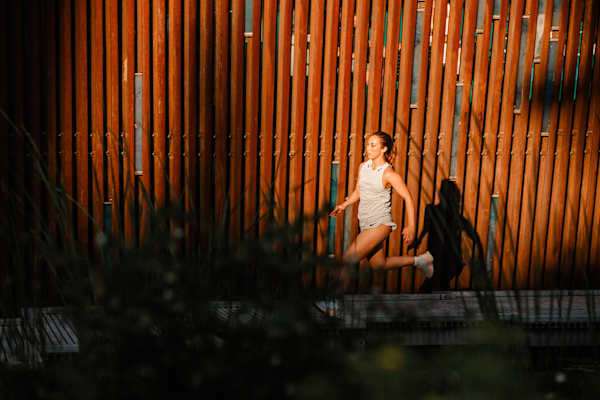Everything You Need to Know About the Triple Jump in Athletics
Sport & activity
In this event, athletes perform a hop, skip and a jump to launch into the air.

The "field" portion of athletics (or track and field) includes four jumping events: the long jump, high jump, pole vault and triple jump. In the triple jump, athletes sprint down a runway and perform three jumps in a row before landing in a sandpit. The three jumps are referred to as a hop, skip (or step) and jump.
The goal: travel as far as possible from the take-off point into the sandpit. While it may sound simple, this jumping event requires a high level of technique and skill, with set rules about which foot athletes are allowed to land on after each jump.
Here's everything you need to know about this fast-paced, highly technical athletics event—the history, what goes into each of the three jumps and what it takes to succeed in the triple jump—according to Erica Ferguson, assistant athletics coach at the University of Connecticut, and Tatijana Jacobson, assistant athletics coach at Duke University.
History of the Triple Jump
According to World Athletics, the international governing body for athletics, the triple jump has been included at every Olympics since the inaugural modern games in 1896. The version performed today, consisting of a hop, skip and jump, was not standardised until 1908. Previously, the event consisted of two hops and a jump.
The triple jump was added as a women's event at the Olympics in 1996.
How It Works: The Three Jumps of the Triple Jump
Triple jumpers begin each attempt by sprinting down the runway to build up speed and momentum. The minimum length of the runway is 40 metres (131 feet), according to the USA Track and Field Rule Book.
At the end of the runway, there's a take-off board: a rectangular, white piece of wood or other rigid material sunk into the track. The take-off board is 18 centimetres (approximately 7 inches) to 22 centimetres (approximately 8.6 inches) long. Upon reaching the take-off board, the athlete must launch off one foot into the sandpit. If their jumping foot lands beyond the board, the jump is considered a failed attempt.
In the triple jump, the initial take-off begins on one foot, which launches the athlete into the first of three jumps, called the hop.
Jump 1: Hop
In the hop, athletes jump forwards off one of their feet. For different jumpers, this can be their stronger or weaker side, said Jacobson, and it really depends on the athlete's preference.
The tricky part, she said, isn't the jumping portion of the hop; it's the landing. That's because, in the triple jump, the landing of the hop must be on the same foot the athlete used to take off. If the triple jumper takes off on the hop with their left foot, they need to land on their left foot to initiate the second jump, called the step or skip.
Jump 2: Step or Skip
At the end of the hop, the jumper lands on the same foot they used to take off at the start (in this example, the left foot). To perform the step or skip, the athlete jumps forwards with that same leg again.
The athletic challenge of transitioning from the hop to the skip comes from being able to absorb the force of the first jump and then transition it into the second jump, said Ferguson.
At the end of the skip, the triple jumper lands on the opposite foot (in this example, the right foot). The athlete will then launch off their right foot to perform the final leap, which is called the jump.
Jump 3: Jump
On the jump, the athlete jumps as far as possible off their final foot into the sandpit. The distance they've travelled from the take-off board to the end of this jump is their total distance covered for the attempt.
According to World Athletics, athletes typically get six jump attempts. However, some competitors with shorter marks can be eliminated after three jumps. The jumper with the longest overall attempt is the winner. In the case of a tie, the second-longest jump performed by the tied athletes is used as a tiebreaker.
How Far Do Triple Jumpers Jump?
At the 2020 Olympic Games, the winning marks were 15.67 metres in the women's competition and 17.98 metres in the men's competition.
The men's world record, set in 1995, is 18.29 metres. The women's world record, set in 2022, is 15.74 metres.
What Equipment Do Triple Jumpers Need?
Triple jumpers, like high jumpers and long jumpers, require minimal equipment to compete: a pair of jumping shoes and high-quality athletic apparel.
Nike track spikes for jumpers are studded with metal spikes that grip the surface of the runway. They're made with a fairly stiff plate on the bottom that creates a stable base for when jumpers take off but have cushioning in the midsole to absorb the impact of the jumps.
Words by Greg Presto






























